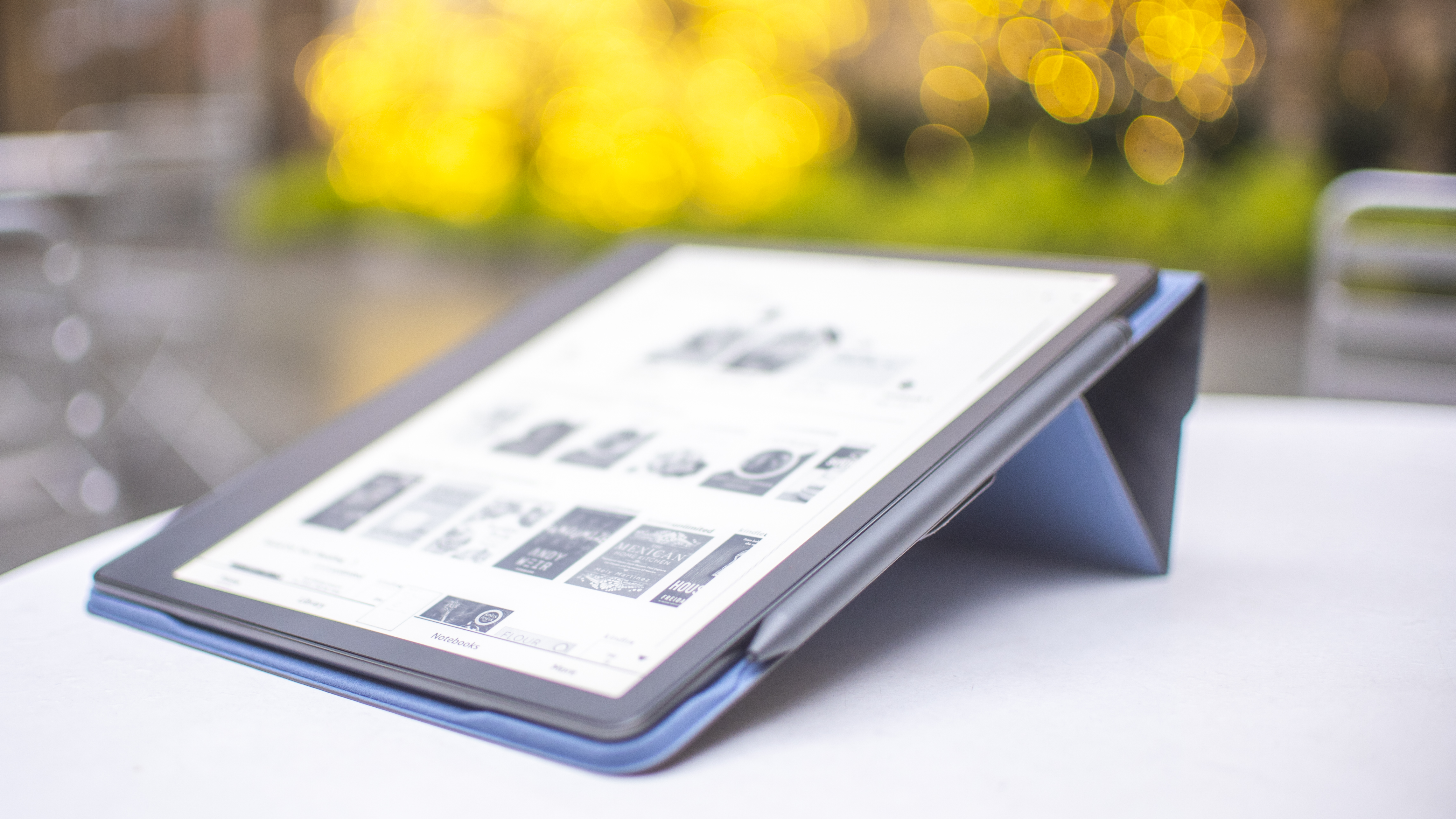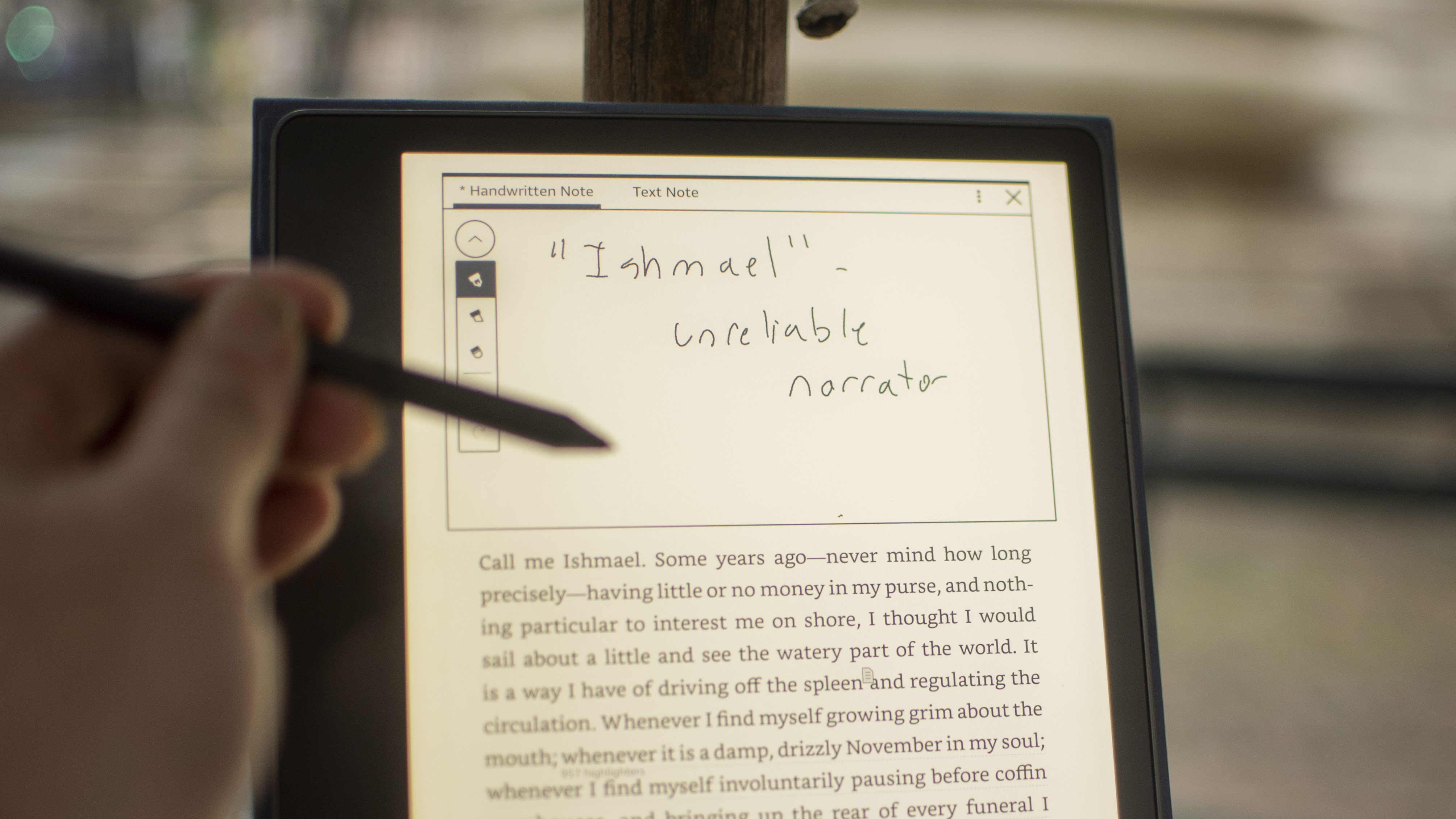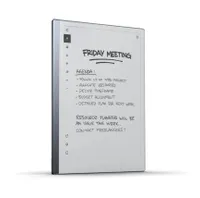TechRadar Verdict
The Kindle Scribe is a great Kindle if you want to read on the biggest, sharpest screen possible. The writing features are a nice addition, and while it can't quite measure up to dedicated e ink writing tablets, Amazon has made improvements to both the tablet and the Kindle store that give you many more options for taking notes and keeping a journal.
Pros
- +
Good price for a stylus-toting E Ink tablet
- +
Finally, a large Kindle screen for reading
- +
More pen options and 'write on' books added since launch
Cons
- -
Few writing features for journaling and doodles
- -
You can’t write in the margins of books
- -
Not many 'write on' books available yet
Why you can trust TechRadar
Editor's Note
• Original review date: November 2022
• Improvements in software since its launch
• Launch price: $339 / £339 / AU$549
• Official price now: $339 / £329 / AU$549
Updated: January 2024. The Amazon Kindle Scribe is for people who want an ereader and a notebook in one, but don't want to fork out the money for a tablet. It succeeds on these fronts offering a great display that's fine for perusing digital books as well as scribbling notes on. At the time of writing, it looks to have dropped a little in price in the UK but staying the same in the US and Australia; we recommend checking out sales events like Black Friday to score the best prices on the Kindle Scribe. But overall it still delivers an ereader-meets-virtual-notebook experience that's hard to beat even some 18 months after we reviewed it. The rest of this review remains as previously published.

One-minute review

The Kindle Scribe has improved enough since it launched to become my preferred tablet to recommend if you like reading, journaling, and now maybe even old school pen and ink games like crossword puzzles and sudoku. It has the biggest screen you can find on a Kindle, while keeping the display just as sharp as the best Kindle ereaders, so books and text look amazing, even better than reading on the best iPad.
If you’re a hardcore handwriter and note-taker, you might prefer the Remarkable 2 tablet, which has many more options for pen styles, background templates, and productivity. The Kindle Scribe still has advantages, especially its backlight that lets you read and write in the dark, which the Remarkable can’t manage. The Kindle Scribe keeps things simpler, and this will work better for most people who aren’t using the writing tablet in the boardroom. The Scribe’s cost is also more consumer-friendly.
I originally complained that the Kindle Scribe couldn’t write in the margins of books, a feature I would love for students, as a former teacher. Sadly, this isn’t Amazon’s fault, and unless you buy books as .pdf files or more industry-specific .epub files, no writing tablet lets you write on any books as you please. Amazon does own a bookstore, so it has come up with a solution since the Kindle Scribe launched.
There are now ‘write on’ books in the Kindle store, and those let you write directly on the page on your Kindle Scribe. This turns out to be a game changer, because the selection, while small, is already unique and helpful. You get pre-filled journaling pages, some crossword and sudoku puzzles, and the promise of more to come. The possibilities are endless, and I’d love to see Amazon encourage some self-publishing in this ‘write on’ zone, to build Scribe adoption.
Kindle Scribe review: price and availability
- $339.99 / £339.99 / AU$549.99 for 16GB with basic pen
- Premium pen includes eraser and shortcut button

It’s hard to compare the pricing on tablets like the Kindle Scribe, considering different note-taking E Ink devices come with different feature sets. Overall, though, if you opt for the 16GB Kindle Scribe with the Basic Pen, there's decent value for what you get.
Sign up for breaking news, reviews, opinion, top tech deals, and more.
For example, the Kobo Elipsa comes in just one model that boasts 32GB of internal storage and ships with both the stylus and a sleepcover for $399.99 / £349.99 / AU$599.95 – so I'm inclined to say the Elipsa offers more value, but the writing experience isn't as smooth.
On the other hand, the reMarkable 2 costs a deceptive $299 / £299 / AU$499. I say deceptive because reMarkable doesn’t include a pen (which the Kindle Scribe and other writing tablets include) and charges exorbitant fees for accessories. The reMarkable also doesn’t have a backlight, so you need a light source to use it in the dark. It also cannot access the Kindle library, or any large eBook library easily.
Weight: 433g
Dimensions: 196 x 230 x 5.8mm
Display size: 10.2-inch
Storage: 16, 32, 64GB
Charging: USB-C charging
Backlight: LED (35 lights)
Pen Included: Yes
The Onyx Boox Note Air2 series isn't as widely available, but starts at $499 in the US for the base model. There are even more advanced E Ink tablets that use a pen, like the Onyx Boox Tab Ultra. That tablet is a more feature-packed device, and in its own class in terms of capability and price. It has a camera for document scanning and runs Android, for instance. For that reason, it’s almost twice the price of Amazon’s Kindle Scribe in the US.
Of course, let's not forget the iPad 10.2 (2021) which, incidentally only has a 264ppi resolution screen as compared to the Kindle Scribe's 300ppi e ink display, and prices start at $329 / £319 / AU$499 without a pen for 64GB of storage. Of course, comparing a colorful, extensible tablet like the iPad to the Kindle Scribe is like comparing apples to, er… Kindles.

The more interesting price comparison is between the Kindle Scribe and other Kindle ereaders. The Scribe costs $90 / £110 / AU$150 more than the Kindle Oasis, which has only a 7-inch display, half the storage space, and no pen support. The only thing the Scribe cannot do is take a dip in the ocean, which the Kindle Oasis can legitimately handle, saltwater and all.
Kindle Scribe review: design
- Big and bright display doesn’t sacrifice sharpness
- Port and power are weirdly placed on the side
The Amazon Kindle Scribe looks like a much larger version of the Kindle Oasis, thanks to the all-metal chassis. Where it differs, other than the obvious size, is the missing page-turn buttons and the asymmetric thickness that I love on the Oasis.
The Kindle Scribe has rounded corners and smoothly curved edges with a wide, flat back, which interestingly has four tiny nubs for feet. It has a bezel all around, with a larger edge on the left side, if you hold the tablet Amazon smile-up. You can flip the Scribe and hold the larger edge with your right hand, but then the Amazon logo will be frowning.
The USB-C port for charging, as well as the power button are both strangely placed on the side of the device, near the middle, but this isn't unique to the Scribe and can be seen on the Onyx Boox Note series tablets too.

The pen, which is included, hangs on by a magnet on the opposite side edge of the Scribe. This is my least favorite way of holding a pen. The strongest rare earth magnets cannot keep a pen in place when I slide a tablet in and out of a backpack sleeve. I lost the Scribe pen on day one and spent a half hour searching before I found it. Thankfully, an old Galaxy Note pen works just as well in a pinch.
If you spring for the leather folio case – a nice addition that Amazon sent along with my review sample but you'll need to buy it separately – the flap opens up over the top like a reporter’s notebook, though much larger, similar to the sleepcover for the Kobo Elipsa (which ships with the tablet itself). The pen then slots into a holder on the edge of the flap.

Compared to the competition, the Kindle Scribe is a bit thicker than the reMarkable 2 tablet – which makes sense because the reMarkable lacks a backlight – but is slimmer and sleeker-looking compared to the plastic body of the Kobo Elipsa. The Kindle has a very bright LED backlit screen, and it can switch from a bluish-gray tint to a blue light-free tint that’s better for nighttime reading.
The Kindle Scribe is also wider than the reMarkable and Elipsa, and less tall, but has identical overall dimensions as the Onyx Boox Note Air2 tablets. The screens are all roughly the same size, it’s just that the reMarkable puts its big bezel edge at the bottom instead of the side.
For reading, I found the Kindle very comfortable to hold and use, even for such a large tablet. I'd love to see it shed some weight, but it isn’t clumsy.

Kindle Scribe review: using it
- Excellent large screen Kindle for reading books
- Middling E Ink writing tablet for journaling and notes

If you want to read books on a large-screen Kindle, the Scribe is an easy ereader to recommend, although the price is high for the category. Still, the screen is much larger than the next-biggest Kindle Oasis' 7-inch display and there's no sacrifice of the remarkable pixel density, so everything is super sharp and glorious on screen. If you’ve been craving a gigantic reading screen for bigger fonts and larger images, the Scribe is a joy to use.
On the other hand, if you’ve been excited about a Kindle that you can also use for journaling, note taking, and other writing tasks, the Kindle Scribe isn't the best tablet you can buy, but it does have plenty of writing features, and you can always buy more journaling books and templates from the Kindle store.
For students and academics, the Scribe only allows you to write notes as sticky notes appended to a book. You cannot actually write on the book page, in the margins, for instance. College students who buy their own books love the ability to interact directly with the text in writing, and it is a huge letdown that no current writing tablet can support this feature on every book you buy.

For journaling and freewriting, the Kindle Scribe offers few template options, and none that work well with popular journal methods. I use bullet journaling and found some basic dots and lined pages, but nothing as organized or creative as the templates I enjoy on the reMarkable 2 tablet. Even the Kobo Elipsa offers a lot more when it comes to note-taking, including adding formulae and diagrams in between notes. If you keep a journal or take detailed notes, I'm saying there are better options out there, and at a similar price point.
Since it launched, Amazon has added more pen options to the Kindle Scribe, including more styles and thickness levels. It isn't quite as robust as the reMarkable tablet, but it's a great improvement over the original offering. Hopefully we'll see even more options in future updates, but Amazon hasn't promised anything.
It isn’t difficult to use the Kindle Scribe for basic productivity. When I needed to sign a document, I simply sent it to a custom email address that I set up through my Amazon Kindle account. The PDF file arrived on my Scribe, and I could sign it and email it back with no trouble. But this will be difficult for anyone without a Kindle account. So, again, the Scribe is best served when you're embedded into the Amazon ecosystem. Even as an ereader, it's best used by customers already with existing Prime, Kindle Unlimited or Audible accounts.
The writing experience on the Scribe with even its Basic Pen is the best I've experienced to date. It is smooth as paper, and even that doesn't quite convey how good it really is to write on that screen.
Kindle Scribe review: connectivity

- Easy setup over Wi-Fi, no device needed
- Send documents to a dedicated email address
Amazon makes it easy to set up the Kindle Scribe and get all of your books and documents on and off the device. I had no trouble finding my Wi-Fi network, and the Kindle does not need a second device for setup. If you have a smartphone with the Kindle app, that helps speed the process along, but it isn’t required.
When I needed to sign documents with the Kindle Scribe, I found a dedicated email address @kindle.com was the easiest way. It is set up with a random username by default, but you can change this online, and I made it more convenient. As soon as I sent a document it appeared in my library, and I could email it from the Kindle Scribe to five recipients.

Of course, there are many more connectivity options I'd like to see, but at this price the options are fair. Some folks may want an LTE connection at least for downloading books or emailing simple black-and-white documents. Amazon sells a deluxe version of the Kindle Oasis with 4G LTE connectivity for downloads on the go, so it's a little strange to see the Scribe miss out... although I suspect the price for that privilege would be quite prohibitive for most potential users.
I could also imagine a microSD card slot being very useful for transferring and signing documents. If this were a more serious productivity tool, that would be a top request, but I've yet to see an alternative E Ink note-taking tablet offer this option.
Should I buy the Kindle Scribe?
Buy it if
You want a really big Kindle for reading books
Since the Kindle DX disappeared almost 10 years ago, there hasn’t been a truly large-screen reader for Kindle ebook fans.
You annotate books using sticky notes
If you already make notes in books by writing on Post-it Notes and slipping them in between the pages, the Kindle Scribe will help you do that... just digitally. But that's about all it will let you do – no scribbling in margins here.
You read a lot and sign things from time to time
The Kindle Scribe makes it very easy to mark up and sign PDF documents, even easier than it is to take notes in books. If that’s your gig, the Kindle Scribe will help you work.
Don't buy it if
You want to take notes in margins
No e ink reader will let you write directly on every book you own, but at least you can still make sticky notes and attach them to specific pages.
You’re into journaling and doodling
The Kindle Scribe has fewer writing features than some other tablets, though Amazon has added better pen options since the Scribe originally launched.
Kindle Scribe review: also consider
If our Kindle Scribe review still has you on the fence then consider this trio of alternatives below:
Onyx Boox Note Air 2
This is hands-down one of the best digital note-takers we've tested. The biggest advantage it offers is access to the Google Play Store as it runs Android 11. And I mean the full Play Store. So not only can you sideload ebooks, you can also download the Kindle, Kobo or Scribd app to access any of your libraries. And it's got so many options when it comes to note taking, journaling or just doodling.
Read our full Onyx Boox Note Air 2 review.
If you need more battery life, the Onyx Boox Note Air 2 Plus is an even better option.
Kobo Elipsa
The Kindle Scribe is the Elipsa's direct competition – they're both first and foremost ereaders, just with the added advantage of a pen to write on the tablet with. However, the Elipsa gives you far more annotating and note taking options, with the ability to convert handwriting to type, uploading directly to Dropbox and even adding drawings or formulae to notes. Plus the Elipsa has 32GB of storage and ships with the sleepcover too, so offers more value for money.
Find out more in our in-depth Kobo Elipsa review.
reMarkable 2
If you want to start a journal, or if you want to draw and be more creative, turn to the reMarkable 2. It has many more pen options to change the look and feel, and it includes many more templates to write upon. If only it had a backlight for nighttime use, and came with the pen in the box instead of being an optional add-on.
Check out our reMarkable 2 review.
- First reviewed: November 2022

Starting more than 20 years ago at eTown.com. Philip Berne has written for Engadget, The Verge, PC Mag, Digital Trends, Slashgear, TechRadar, AndroidCentral, and was Editor-in-Chief of the sadly-defunct infoSync. Phil holds an entirely useful M.A. in Cultural Theory from Carnegie Mellon University. He sang in numerous college a cappella groups.
Phil did a stint at Samsung Mobile, leading reviews for the PR team and writing crisis communications until he left in 2017. He worked at an Apple Store near Boston, MA, at the height of iPod popularity. Phil is certified in Google AI Essentials. His passion is the democratizing power of mobile technology. Before AI came along he was totally sure the next big thing would be something we wear on our faces.
- Sharmishta SarkarManaging Editor (APAC)



